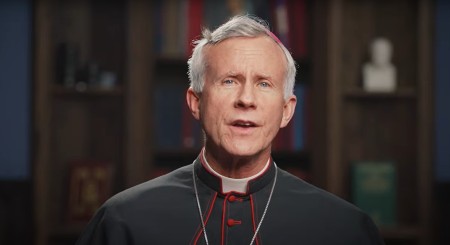 Dear readers, Catholic Online was de-platformed by Shopify for our pro-life beliefs. They shut down our Catholic Online, Catholic Online School, Prayer Candles, and Catholic Online Learning Resources—essential faith tools serving over 1.4 million students and millions of families worldwide. Our founders, now in their 70's, just gave their entire life savings to protect this mission. But fewer than 2% of readers donate. If everyone gave just $5, the cost of a coffee, we could rebuild stronger and keep Catholic education free for all. Stand with us in faith. Thank you. Help Now >
Dear readers, Catholic Online was de-platformed by Shopify for our pro-life beliefs. They shut down our Catholic Online, Catholic Online School, Prayer Candles, and Catholic Online Learning Resources—essential faith tools serving over 1.4 million students and millions of families worldwide. Our founders, now in their 70's, just gave their entire life savings to protect this mission. But fewer than 2% of readers donate. If everyone gave just $5, the cost of a coffee, we could rebuild stronger and keep Catholic education free for all. Stand with us in faith. Thank you. Help Now >
The Happy Priest: Why Did Jesus Rise with Wounds?
FREE Catholic Classes
Highlights
Catholic Online (https://www.catholic.org)
5/2/2011 (1 decade ago)
Published in Living Faith
Keywords: redemptive suffering, Thomas, Doubting Thomas, Divine Mercy, Fr James Farfaglia
CORPUS CHRISTI, TX (Catholic Online) - Did you ever stop to think why Jesus rose from the dead with wounds? Jesus rose from the dead with a glorified body. The barriers of time and space no longer apply to him. The Lord appears and disappears with shocking suddenness. He continually demonstrates his physical reality. The Apostles and the disciples see him, hear him and eat with him. Thomas is told to touch his wounds. The stone rolled away from the entrance and the carefully folded burial cloths direct our gaze to the physical. He has truly risen.
The disbelief and uncertainty evidenced by those who saw him testify to an apparent strangeness in the appearance of the newly risen Christ. Slowly they came to recognize him, but they still struggled with doubt. We are accustomed to an annual celebration of Easter. However, for the first disciples of Jesus, resurrection was totally new. Let us remember, that the son of the widow of Nain, Jairus' daughter and Lazarus were all brought back to life by Jesus, but not one of them continued their lives with a glorified body.
Although the risen Jesus is the same Jesus that died on Calvary, his physical reality is now different than before. The body of the risen Lord is indeed his physical body, but he now moves about with a glorified body. Each of us will have a glorified body also at the resurrection of the dead if we persevere and are faithful.
Over and over again the gospels stress that something extraordinary has occurred. The Lord is tangible, but he has been transformed. His life is different from what it once was. His glorified body transcends the limitations of time and space. For this reason he can pass through the closed door of the Upper Room. He appears and disappears as he desires.
At times his disciples cannot recognize him precisely because their physical reality moves within time and space, and the Lord's physical reality is no longer subject to time and space, although he exists within time and space.
The empty tomb and the neatly folded burial cloths point to us that Jesus is physically alive. His crucified body has been transformed. What lesson is he teaching us by keeping his wounds intact?
We can answer this question by turning to our own wounds. Deacon Keith Fournier in his book Wounds that Heal reflects on this theme very beautifully with a rich spirituality characteristic of his writing and preaching.
First, we all experience the large wound caused by original sin. Although we are baptized and original sin has been cleansed from our soul, our human nature has been wounded. Our sinful condition manifests itself in different ways and we struggle with those manifestations of fallen human nature.
And then there are the other wounds, the wounds that are smaller. We have wounds that are caused by sickness and the wounds that are caused by problems, adversities, challenges and the disappointments of life.
All of us are wounded. Even Jesus is wounded. By retaining the wounds of his passion, the glorified Jesus is showing us that we can find hope and strength by taking our wounds and uniting them to his wounds.
The eleven apostles of today's gospel passage were discouraged and filled with fear. They had lost all hope. They did not understand that Jesus had to first die on the cross in order to rise on Easter Sunday. They did not understand that the risen Jesus would bear his five wounds as an eternal reminder that when our wounds are united to his wounds we will find true peace.
"Peace be with you". These are the first words of the risen Jesus. He dispels the darkness of discouragement, despair and fear by showing the eleven his glorified and wounded body.
Thomas places his finger in the wounds of Jesus and he believes. "Put your finger here and see my hands, and bring your hand and put it into my side, and do not be unbelieving, but believe". (John 20: 27)
Many call Thomas the doubting Thomas. All of the Apostles doubted. All of the Apostles ran away and abandoned Jesus. In reality, he is not the doubting Thomas, but the courageous Thomas. He is the only apostle who knows where to find Jesus.
By touching the wounds of Jesus, he begins to understand that the risen Jesus is not a ghost, but that he is truly real. By encountering Jesus in his woundedness, he is able to encounter the authentic Jesus, the real Jesus, the whole Jesus. Because he is able to encounter the Jesus that shed his blood on the cross, he falls to the ground and pronounces a profound act of faith: "My Lord and my God". Thomas is able to encounter Jesus in all of his humanity and all of his divinity. He comes to grasp the reality that the risen Jesus is the same Jesus that died on Calvary.
But, where is the risen and wounded Jesus? Where can we encounter him? As Jesus hung on the cross, all of his blood flowed from his wounds. The eternal reminder of his wounds reminds us that we are to experience him in the Eucharist and in the Sacrament of Confession.
By coming to Jesus every day at Mass, for visits and adoration; by encountering the God of mercy through the awesome gift of the sacrament of forgiveness, we can dispel the despair, the discouragement and the fear that may fill our lives.
It is in the Eucharist that we encounter peace because we truly encounter the Lord. We need to bring our wounds to the risen and wounded Jesus every day in the Eucharist. It is there, at the tabernacle, that his wounds will heal us.
On this feast of Divine Mercy Sunday, let us remember the words that Blessed John Paul II wrote in his second encyclical letter: "Believing in the crucified Son means 'seeing the Father,' means believing that love is present in the world and that this love is more powerful than any kind of evil in which individuals, humanity, or the world are involved. Believing in this love means believing in mercy. For mercy is an indispensable dimension of love; it is as it were love's second name and, at the same time, the specific manner in which love is revealed and effected vis-a-vis the reality of the evil that is in the world, affecting and besieging man, insinuating itself even into his heart and capable of causing him to perish in Gehenna" (Dives in Misericordia).
-----
Father James Farfaglia, the Happy Priest, is the pastor of Saint Helena of the True Cross of Jesus Catholic Church in Corpus Christi, Texas and is a member of the Board of Directors of Human Life International. Father has a hard hitting blog called Illegitimi non carborundum. He has also published a book called Man to Man: A Real Priest Speaks to Real Men about Marriage, Sexuality and Family Life. His second book, Get Serious! will be available soon. You can visit Father James on the web at www.FatherJames.org.
---
'Help Give every Student and Teacher FREE resources for a world-class Moral Catholic Education'
Copyright 2021 - Distributed by Catholic Online
Join the Movement
When you sign up below, you don't just join an email list - you're joining an entire movement for Free world class Catholic education.
-

-
Mysteries of the Rosary
-
St. Faustina Kowalska
-
Litany of the Blessed Virgin Mary
-
Saint of the Day for Wednesday, Oct 4th, 2023
-
Popular Saints
-
St. Francis of Assisi
-
Bible
-
Female / Women Saints
-
7 Morning Prayers you need to get your day started with God
-
Litany of the Blessed Virgin Mary
5 Biblical Warnings We All Must Heed
-

WHAT WILL IT TAKE? | Bishop Strickland Calls Out Silent Bishops in Strong Public Letter
-

Giants of the Fallen: Unveiling the Mystery of the Nephilim from a Catholic Perspective
-
Ancient Wisdom, Modern Choices: How Ecclesiastes 10:2 Illuminates Today's Political Divide
-
How Do We Know Truth? A Catholic Perspective
Daily Catholic
 Daily Readings for Sunday, November 17, 2024
Daily Readings for Sunday, November 17, 2024 St. Elizabeth of Hungary: Saint of the Day for Sunday, November 17, 2024
St. Elizabeth of Hungary: Saint of the Day for Sunday, November 17, 2024 Prayer to Saint Anthony of Padua, Performer of Miracles: Prayer of the Day for Sunday, November 17, 2024
Prayer to Saint Anthony of Padua, Performer of Miracles: Prayer of the Day for Sunday, November 17, 2024- Daily Readings for Saturday, November 16, 2024
- St. Hugh of Lincoln: Saint of the Day for Sunday, November 17, 2024
- Prayer for Life: Prayer of the Day for Saturday, November 16, 2024
![]()
Copyright 2024 Catholic Online. All materials contained on this site, whether written, audible or visual are the exclusive property of Catholic Online and are protected under U.S. and International copyright laws, © Copyright 2024 Catholic Online. Any unauthorized use, without prior written consent of Catholic Online is strictly forbidden and prohibited.
Catholic Online is a Project of Your Catholic Voice Foundation, a Not-for-Profit Corporation. Your Catholic Voice Foundation has been granted a recognition of tax exemption under Section 501(c)(3) of the Internal Revenue Code. Federal Tax Identification Number: 81-0596847. Your gift is tax-deductible as allowed by law.








 Daily Readings for Sunday, November 17, 2024
Daily Readings for Sunday, November 17, 2024 St. Elizabeth of Hungary: Saint of the Day for Sunday, November 17, 2024
St. Elizabeth of Hungary: Saint of the Day for Sunday, November 17, 2024 Prayer to Saint Anthony of Padua, Performer of Miracles: Prayer of the Day for Sunday, November 17, 2024
Prayer to Saint Anthony of Padua, Performer of Miracles: Prayer of the Day for Sunday, November 17, 2024

